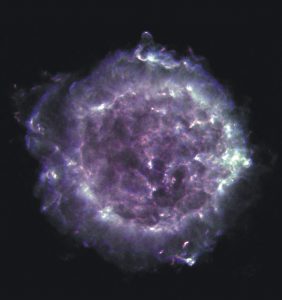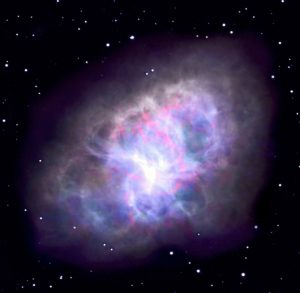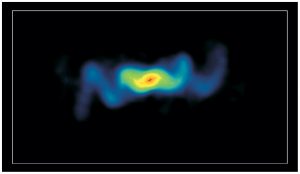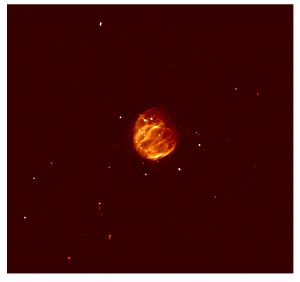Cassiopeia A is the remnant of a supernova explosion that appeared in our sky over 300 years ago in our Galaxy, at a distance of about 11,000 light years from us. Its name is derived from the constellation in which it is seen: Cassiopeia, the Queen. A supernova is the explosion that occurs at the end of a massive star’s life; and Cassiopeia A is the expanding shell of material that remains from such an explosion. This radio image of Cassiopeia A was created with the National Science Foundation’s Very Large Array telescope in New Mexico. Cassiopeia A is one of the brightest radio sources in the sky, and has been a popular target of study for radio astronomers for decades. The material that was ejected from the supernova explosion can be seen in this image as bright filaments.


Crab Nebula
The Crab Nebula, located in the constellation of Taurus, is the remnant of a star that exploded in 1054 AD. The nebula is roughly 10 light-years across, and it is at a distance of about 6,000 light years from earth. It is presently expanding at about 1000 km per second. The supernova explosion left behind a rapidly spinning neutron star, or a pulsar (not discernible in this image). The present remnant is formed from both the material originally thrown off by the star in the supernova explosion, and from a highly energetic wind from the pulsar. It is this wind which energizes the nebula, and causes it to emit the radio waves (purple, blue, green). Gases glow so brightly that they can be seen optically as well (red).

A Wobbling Jet
Inside the famous Manatee Nebula (W50) lies the black hole remnant of the supernova that formed it, called SS 433. Its jets wobble as they force charged particles outward. Over time, this creates a swirling tracer pattern to the radio waves picked up by the Very Large Array (VLA).

Glowing Bubble of an Exploded Star
Radio image of supernova remnant G55.7+3.4 shows previously-unseen filamentary structure, thanks to enhancements made to the Very Large Array (VLA).

Across the Milky Way (blue version)
A radio and infrared wave panorama of a section of the Milky Way in the constellations of Scutum and Aquila. Normal stars show up as the myriad of blue-white points. Radiation from the newborn stars heats surrounding dust into infrared temperatures (in blue), while the ultraviolet light from these stars separates electrons from hydrogen atoms, and gives off radio waves (in red). More mature stars have destroyed nearby dust, leaving red cores surrounded by pink, then blue, shells as the temperature drops far from the stars. Massive stars have died in titanic explosions and blasted their gas light years into space at thousands of miles per second, leaving blast arcs (in red). The diffuse infrared glow (blue) comes from the tiny dust particles scattered through space.

Across the Milky Way (teal version)
A radio and infrared wave panorama of a section of the Milky Way in the constellations of Scutum and Aquila. Normal stars show up as the myriad of aqua-white points. Radiation from the newborn stars heats surrounding dust into infrared temperatures (in teal), while the ultraviolet light from these stars separates electrons from hydrogen atoms, and gives off radio waves (in red). More mature stars have destroyed nearby dust, leaving red cores surrounded by pink, then teal, shells as the temperature drops far from the stars. Massive stars have died in titanic explosions and blasted their gas light years into space at thousands of miles per second, leaving blast arcs (in red). The diffuse infrared glow (teal) comes from the tiny dust particles scattered through space.





